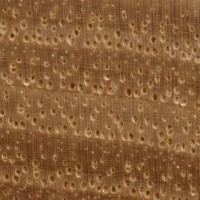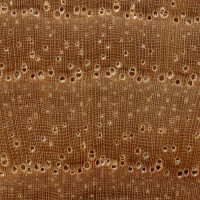by Eric Meier
The Carya genus (or what is more commonly referred to as Hickory) is divided into two main groupings: true-hickory, and pecan-hickory. Species in the true-hickory group tend to be slightly denser, and therefore a bit harder and stronger than the species in the pecan-hickory group. However, because the two ranges of densities so closely overlap, using the weight of the wood to separate hickory is unreliable.
True Hickories: |
Pecan Hickories: |
Distinguishing between these two groups of hickory is fairly straightforward. The quickest and easiest means of differentiating them is by observing the bands of parenchyma—in pecan-hickories, the bands are present in both the earlywood and latewood portions of the wood. In true-hickories, the bands of parenchyma are absent from the earlywood portion of the wood.
The sample of Shagbark Hickory on the left lacks parenchyma bands in the earlywood zone—characteristic of true-hickory. The sample of Pecan on the right shows uninterrupted bands even through the earlywood zone, indicating pecan-hickory. (Click for enlargements)
In addition to the continuous parenchyma bands (in reticulate pattern), another indicator of pecan-hickory is a tendency to be more semi-ring-poroous rather than strictly ring-porous, with a more gradual transition from the larger earylwood pores to the smaller latewood pores. However, although the two groups of hickory can be reliably separated, identifying particular species within each grouping is usually not possible.
Get the hard copy







Also what is this tree
I found a bunch of trees that were yellow to golden colour when cut but dryed out to a brownish color does any one know what kind of trees it could be
Couldn’t say for certain, but the most brilliantly sulfur yellow wood i ever saw was from a freshly cut Black Locust tree. Robinia pseudoacacia.
Hi Eric, the specimen in these photos was cut from a smoking board and I am trying to figure out the exact species (the width of the photos is 1.2 cm and 5 cm, respectively). From your description above I would go with a true hickory and shagbark hickory seems to be the closest match. Would you agree with my guess? Thank you!
Yes, I agree with your ID that the sample is in the true hickory group based on the lack of parenchyma in the earlywood zone. However, to my knowledge there isn’t a reliable way to ID true hickories down to a species level. Ideally you’d want to see a standing tree for that level of precision.
Thanks much for your reply Eric, much appreciated!
I am having a hard time seeing the difference in the end grains. I am trying to tell whether or not I have a true hickory or a pecan hickory. This is the end grain shot.
I don’t blame you, it’s almost impossible to make out enough detail in that picture to say one way or the other. I think you’ll either have to sand the endgrain to a finer grit (if that’s the limiting factor), or else get a closer and cleaner shot of the endgrain. With smartphone cameras, they perform best with good lighting conditions, so direct sunlight is best.
I’ve looked at multiple samples and it seems there is overlap.
Within the same piece, some rings will have the reticulate parenchyma reach low and a year later there is a clear vertical only zone with no horizontal bands. They do spread out and get thinner on what I imagine are Hickories and are much more numerous on Pecans. But the species interbreed, also maybe growth conditions affect?
Trees don’t read textbooks.
There are no such thing as true or pecan hickory.Pecan is a hickory from Carya genus.Somme hickory like the pecan is, grow faster thats why they are slightly denser .Also all of these hickory including the pecan,crossbreed offten in the wild ,hican trees being even comercially available.
Well then, my dendrology professor must be mistaken…
I am a Certified Forester. You are wrong. I understand your point, that “pecan” is a species within the Carya (hickory) genus. The phrase “pecan hickory” is, however, in fact used to differentiate species within the Carya genus in the manner explained above.
The details and knowledge provided has been both interesting and beneficial in my firewood collection and general interest as an avid outdoorsman and hardwood heating hoarder?